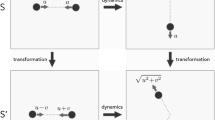Abstract
Causality in physics is an old idea which emphasizes the notion that there are ‘causes’ and ‘responses’ to those causes; this relationship is expressed through a fundamental equation which is supposed to describe the evolution of a dynamical system of particles. In a most elementary example, one may identify the power input to a system as the ‘cause’ and the rate of change of the internal plus kinetic energy of the system as representing the ‘response’. In this case, the balance of one against the other is a statement of balance of energy for the dynamical system; such balance is often postulated as fundamental in mechanics. It is the purpose of this paper to investigate a more fundamental causality based approach for describing the dynamics of a system of particles. Forces intrinsic and extrinsic to the system are distinguished and an evolutionary causality law, which is form-invariant under a change of frame, is proposed. We assume, as is common, that intrinsic forces are objective under a general change of frame. Extrinsic forces are assumed to be objective only under a Galilean (that is, inertial) change of frame. This limited objectivity will play a major role in reducing the fundamental proposed ‘law of causality’ to what is recognized as the classical balance of energy for the system. The concept of mass is not introduced as primitive in this work; the existence of ‘inertial constants’, each of which associates with a specific particle of the system, is a result of the theory. Double and triple binding forces between pairs and triples of particles are admitted as fundamental to the intrinsic force structure of this theory. The balance of linear momentum for the system is derived and a generalized intrinsic force action-reaction principle is obtained. The emergence from the causality theory of pair- and triple-particle potential functions is discussed and these potential functions are shown to be intimately related to the internal binding force structure. Moreover, in Theorem 6.1 the underlying invariance structure of the theory shows that the double and triple binding forces must be separately ‘moment-balanced’ and that this gives rise to the balance of moment-of-momentum for the system. Finally, a constitutive theory for the binding forces is posited and it is shown that the double binding forces are determined by the pair-particle potential function and that the triple binding forces are determined by the triple-particle potential function.
Similar content being viewed by others
References
Bunge M.: Causality, The Place of the Causal Principle in Modern Science. Harvard University Press, Cambridge (1959)
Einstein, A.: Foreword to Concepts in Space: The History of Theories of Space in Physics by Max Jammer. Harvard University Press, Cambridge, 1st edn., 1957; 2nd edn., 1969
Fried E.: New insights into the classical mechanics of particle systems. Discrete Contin. Dyn. Syst. 28(4), 1469–1504 (2010)
Jammer, M.: Concepts in Space: The History of Theories of Space in Physics. Harvard University Press, Cambridge, 1st edn., 1957; 2nd edn., 1969
Jammer M.: Concepts of Mass in Classical and Modern Physics. Harvard University Press, Cambridge (1961)
Noll W.: On the continuity of solid and fluid states. Arch. Rational Mech. Anal. 4, 3–81 (1955)
Author information
Authors and Affiliations
Corresponding author
Additional information
Communicated by M. Ortiz
Dedicated to Morton Edward Gurtin, a treasured friend since our time together as graduate students at Brown
Rights and permissions
About this article
Cite this article
Fosdick, R. A Causality Approach to Particle Dynamics for Systems. Arch Rational Mech Anal 207, 247–302 (2013). https://doi.org/10.1007/s00205-012-0567-7
Received:
Accepted:
Published:
Issue Date:
DOI: https://doi.org/10.1007/s00205-012-0567-7




